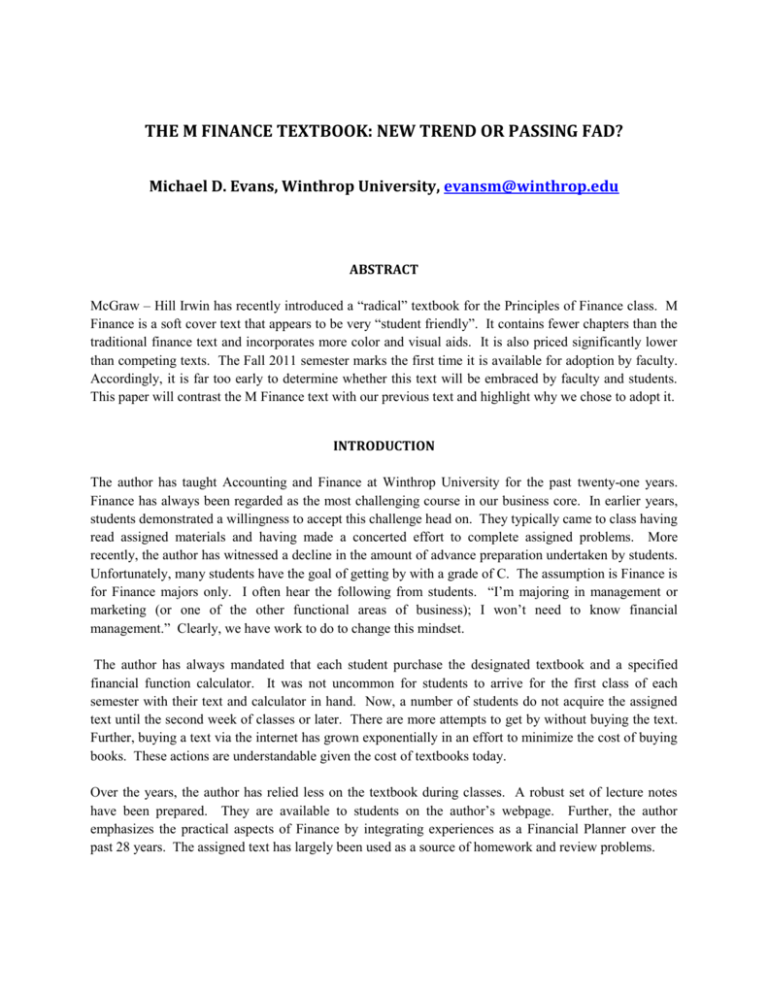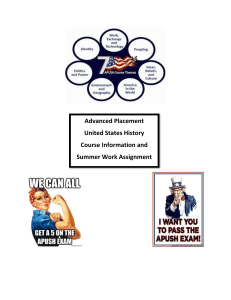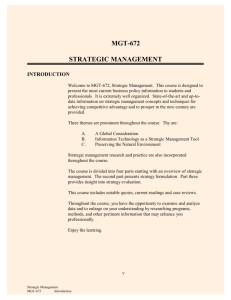The M Finance Textbook: New Trend or Passing Fad?
advertisement

THE M FINANCE TEXTBOOK: NEW TREND OR PASSING FAD? Michael D. Evans, Winthrop University, evansm@winthrop.edu ABSTRACT McGraw – Hill Irwin has recently introduced a “radical” textbook for the Principles of Finance class. M Finance is a soft cover text that appears to be very “student friendly”. It contains fewer chapters than the traditional finance text and incorporates more color and visual aids. It is also priced significantly lower than competing texts. The Fall 2011 semester marks the first time it is available for adoption by faculty. Accordingly, it is far too early to determine whether this text will be embraced by faculty and students. This paper will contrast the M Finance text with our previous text and highlight why we chose to adopt it. INTRODUCTION The author has taught Accounting and Finance at Winthrop University for the past twenty-one years. Finance has always been regarded as the most challenging course in our business core. In earlier years, students demonstrated a willingness to accept this challenge head on. They typically came to class having read assigned materials and having made a concerted effort to complete assigned problems. More recently, the author has witnessed a decline in the amount of advance preparation undertaken by students. Unfortunately, many students have the goal of getting by with a grade of C. The assumption is Finance is for Finance majors only. I often hear the following from students. “I’m majoring in management or marketing (or one of the other functional areas of business); I won’t need to know financial management.” Clearly, we have work to do to change this mindset. The author has always mandated that each student purchase the designated textbook and a specified financial function calculator. It was not uncommon for students to arrive for the first class of each semester with their text and calculator in hand. Now, a number of students do not acquire the assigned text until the second week of classes or later. There are more attempts to get by without buying the text. Further, buying a text via the internet has grown exponentially in an effort to minimize the cost of buying books. These actions are understandable given the cost of textbooks today. Over the years, the author has relied less on the textbook during classes. A robust set of lecture notes have been prepared. They are available to students on the author’s webpage. Further, the author emphasizes the practical aspects of Finance by integrating experiences as a Financial Planner over the past 28 years. The assigned text has largely been used as a source of homework and review problems. The relative efficacy of textbooks has been debated in the literature. Some have suggested that textbooks should be discarded. It is noted that texts are costly and contain far more material than can ever be covered in a semester. We typically offer 4 or more sections of the Principles of Finance course each semester. These sections are taught by 4 professors. Our most recent text was Foundations of Finance, 6th edition by Keown, Martin & Petty. My colleagues and I selected this text because we found it to be one of the more studentfriendly texts that we reviewed. It was more condensed than the typical finance textbook and was fairly easy to understand. Nonetheless, this text contained chapters that we typically did not cover and had a few other limitations as well. In March 2011 the author attended a workshop on Technology in Finance sponsored by McGraw-Hill. The primary purpose of the workshop was to expose the professors to the online tools available for students (e.g. quizzes, study materials) and instructors (e.g. homework manager, quizzes, exams, etc.). During one of our sessions, I mentioned the need to get creative in the classroom and to conduct class discussions in new ways. Being somewhat facetious, I suggested that I was going to write a rap song for selected finance topics. I also mentioned the need for a “different” type of textbook (i.e. one that only included the topics we would likely cover in one semester and was soft cover and concise and colorful in its presentation). McGraw-Hill staff said they had such a text and showed me the M Finance text by Cornett, Adair and Nofsinger. I was impressed with what I saw and immediately shared the text with my colleagues at Winthrop University upon my return. After my finance colleagues had an opportunity to review the text individually, we decided to adopt it for the Fall 2011 semester. A COMPARISON OF THE TWO TEXTS The author has utilized a soft cover text in the Personal Finance class. However, the M Finance text is the first soft cover text I’ve seen for the Principles of Finance class. Further, the cover gives one the appearance of looking at a magazine, hence, its name. It is also much more concise than other texts I’ve reviewed. It contains approximately 360 total pages versus 584 for the Keown text. The following table shows the chapters and topics included in each text. Table 1 – Chapters Chapter 1 2 3 M Finance Intro to Financial Management Reviewing Financial Statements Analyzing Financial Statements 4 5 TVM – Single Cash Flows TVM – Annuity Cash Flows Foundations of Finance Intro to Financial Management Financial Markets & Interest Rates Understanding Financial Statements & Cash Flow Evaluating Firm’s Financial Performance TVM 6 7 8 9 10 11 12 Valuing Bonds Valuing Stocks Understanding Financial Markets Characterizing Risk & Return Estimating Risk & Return Cost of Capital Estimating Cash Flows – Capital Budgeting NPV and Other Capital Budgeting Criteria Working Capital Policies 13 14 15 16 17 Risk & Return Bond Valuation Stock Valuation Capital Budgeting Techniques Cash Flows in Capital Budgeting Cost of Capital Determining the Financing Mix Dividend Policy Short-term Financial Planning Working Capital Management Current Asset Management International Business Finance It has always been my expectation that students should have a working knowledge of the following upon the completion of the principles course. Format of the basic financial statements Ability to analyze the financial statements (i.e. ratio analysis) Time value of money Tools and techniques of capital budgeting (i.e. payback, npv, irr) Further, students should have an understanding of the relationship between risk and return. They should also have a basic understanding of the role of financial markets and institutions in our society. Accordingly, these are the topics that have been emphasized in class. Chapters 1-9 of the Keown text have always been covered. Although, not always in the same order in which they appear in the text. Chapters 11 and 14 have also been consistently covered. Anecdotally, only one of the four professors who teach the principles course covered dividend policy and none covered the last three chapters. It should be noted that finance majors cover each of these topics (i.e. working capital and current asset management and international finance) in subsequent courses. Prior to my discovery of the M Finance text, some of my colleagues were considering ordering a custom text that would leave out some of the chapters from the Keown text. The M Finance text eliminated the need to design a custom text because it did not include the chapters that we were not covering. Further, each chapter is shorter in length and tends to be written in a more conversational style. We believe students will find our newly adopted text easier to read (if they choose to do so!). It clearly is easier to transport and should be available new in our bookstore for under $100. The M Finance text includes tear out sheets containing key formulas grouped by chapter. Professors may elect to allow students to bring the appropriate formula sheet(s) to class on exam dates. At any rate, this should prove to be an effective preparation tool prior to an exam. The downside is that there are no check figures for homework problems in the text. The student site also includes online quizzes, I Pod downloads and video. The instructor site includes the solutions manual, a test bank and PowerPoint lecture slides. It should be noted that the test bank contains overwhelmingly multiple choice questions. There are essay questions and problems for most chapters. However, they are in relatively short supply. From a teaching standpoint, I noticed that one must be diligent to be consistent with some of the approaches used by the authors. For example, the authors multiply accounts receivable by 365 days to compute the average collection period as opposed to dividing annual credit sales by 365. Similarly, the authors place a great deal of emphasis in using formulas to solve examples of time value of money problems. This may prove advantageous for our finance majors because they are required to use formulas in the next finance course in the sequence. A working knowledge of a financial function calculator is likely sufficient for students in other majors. Each example has a calculator hint box that displays the keystrokes. CONCLUSION It’s much too early to tell if the M Finance text will revolutionize the format and content of texts for the principles of finance class. I suspect that some professors will feel that the content is too watered down and will want to stick with a more traditional text. More importantly, it remains to be seen how aggressively the text is marketed. We were using the text from a different publisher so McGraw-Hill Irwin will realize additional revenue from our students. There is some concern that the M Finance text could cannibalize sales of other principles texts published by McGraw-Hill Irwin. Clearly, the M Finance text offers a relatively low cost option for students. Students reported that they were able to purchase the text new from our bookstore for $75. Online prices were lower. The text should prove to be an easy read as it is written in a conversational tone and includes numerous examples that students should be able to relate to.





